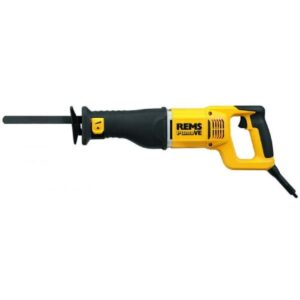The reciprocating saw is the keen DIYer’s best friend. You can use it to cut various materials, including wood, plastic, metal and so on quickly and confidently, with the least amount of effort.
The question is:
How do you go about choosing the right reciprocating saw for your needs?
You’ve come to the right place!
At Plumbing Superstore, we’ve put together a comprehensive reciprocating saw buying guide that covers the main uses of a reciprocating saw and what you need to pay close attention to.
Without further ado, let’s dive right in.
Table of contents:
- What is a reciprocating saw?
- What should I look for in a reciprocating saw?
- Types of reciprocating saw blades
- How many amp reciprocating saw do I need?
- Final thoughts
What is a reciprocating saw?
You might recognise a reciprocating saw when you see one, but what exactly is it? And what are reciprocating saws used for?
Here’s the deal:

A reciprocating saw is essentially an all-purpose motorised power saw used for cutting various materials across construction and demolition projects. It gets its name from the movement of its blade back and forth. In this way, it’s similar to a jigsaw.
What’s more:
A reciprocating saw is a great tool when you need to make quick, rough cuts in metal or PVC pipes located in places that are difficult to reach. Because it’s easy to use, it will save you a lot of time.
Fun fact: In the US, a reciprocating saw is often called a ‘Sawzall’, which was the trade name of the first such tool produced by the Milwaukee Electric Tool Corporation back in 1951.
What should I look for in a reciprocating saw?
Next, we’re going to take a closer look at some of the main reciprocating saw use features you should be aware of.
Corded reciprocating saw vs cordless reciprocating saw
The first thing you need to decide is whether to go for a corded or cordless tool. Both come with their own sets of benefits.
Now:
Corded reciprocating saws tend to cost and weigh less because they don’t require huge, sophisticated batteries and expensive chargers. As an added benefit, you also won’t have to worry about the battery running out. So, you can use the tool for as long as necessary, without any need for time-consuming charging.
In contrast, cordless reciprocating saws offer you a greater range of uninterrupted action, as you’re not limited by the length of the cord or the absence of electric outlets in difficult-to-reach areas. However, cordless tools are also heavier and relatively more expensive.
In addition, you’ll need to make sure they’re charged as needed and factor in the extra time this will take.
Pneumatic reciprocating saws
Also known as air saws, pneumatic reciprocating saws are a popular solution for a variety of garage or workshop applications in particular. Because they don’t need a motor, they’re light and easy to carry, with only an air hose connecting them to an air compressor.
What’s more:
Pneumatic tools are handy and compact, so you can easily operate this small reciprocating saw with one hand. In spite of that, this is still a high-performance, heavy-duty tool, which is especially well suited for use in high-risk, poorly ventilated work sites.
Orbital action vs straight cut reciprocating saws
Most early examples of reciprocal saws, including the aforementioned Sawzall, were straight cut, with the blade only moving back and forth. At the time, this was seen as perfectly satisfactory. That may very well still be the case, depending on the nature of your project.
But what is orbital action?
First appearing in the early 1980s, orbital action introduced an additional, oval or elliptical pattern of movement to a reciprocal saw blade. Because it’s a more aggressive mode of operation, orbital action allows the saw to remove more material in the shape of a faster if somewhat rougher cut.
So, do you need orbital action?
The answer to this question largely depends on the material you’ll be cutting. Research reveals that orbital action works best when cutting wood. On the other hand, you should never use it when cutting metal or PVC, due to the added vibrations.
To solve this issue, some models come with a switch which allows you to alternate between straight-cut and orbital action modes as required. Naturally, they tend to be more expensive, but this option makes using your reciprocating saw even easier.
Types of reciprocating saw blades

Reciprocating saw blades come in a variety of shapes and forms. That being said, we can break them down into five general types based on what they’re designed to cut.
The main factors which distinguish them are:
✔The TPI count (tips per inch)
✔The material of the blade
✔The shape of the blade
Now:
Most reciprocating blades have a TPI or of between 3 and 24. As a general rule of thumb, the lower the TPI count, the better a particular blade is for cutting wood. Conversely, the higher the TPI, the better the blade is for cutting metal.
Wood cutting blades
With a typical TPI count of between 5 and 10, wood cutting blades are designed to cut different types of wood, branches and softer materials. However, you can also use them to cut nails.
Demolition blades
As their name implies, demolition blades are designed for use in heavy-duty applications. As a result, they’re thicker and have a TPI in the 6-11 range, making them ideal for cutting nail-embedded wood and other, harder materials you’re likely to come across in a demolition job.
Combination blades
Combination blades tend to vary in terms of TPI, as they’re intended to cut wood as well as metal. A highly versatile option, they’re your go-to solution in most circumstances.
Metal cutting blades
Metal cutting blades are used to cut thicker materials, such as metal, which is why they have a higher TPI count. That’s typically in the 10 to 18 range but can go as high as 24. Metal cutting blades also leave a smooth edge.
Carbide tipped blades
These blades feature extremely sturdy, highly durable carbide tips, which enables them to cut through the densest materials, including cast iron and even stainless steel. Because carbide tips are so tough, these blades only have a relatively low TPI count of 8.
In addition to the five main types outlined above, specialist blades also exist. Some of the most common ones are:
- Diamond grit blades
- Pruning blades
- Plaster and drywall blades
- Scroll blades
- Flush-cut blades
- Grout scraper blades
How many amp reciprocating saw do I need?
The power of your reciprocating saw motor is measured in amperes. To put it simply, the higher a saw’s amperage, the more powerful it is and the higher the number of strokes per minute (usually within the 2400-3000 range).
Most reciprocating saws currently available on the market are in the 9-15 amp range. And bigger is always better, right?
Not necessarily.
The thing is:
Even the best reciprocating saw money can buy might not be right for you. Besides, you don’t want to be overspending on a tool you’re only going to use sparingly.
At the end of the day, it all depends on the type of jobs you’re going to be taking on. If you’re a professional working on large-scale, heavy-duty demolition projects day in and day out, you’re well justified in purchasing a top-end, more powerful, more expensive tool. After all, such a tool is your bread and butter.
On the other hand, if you’re a DIYer, an 11 amp reciprocating saw ought to be more than sufficient, even if you’re faced with a fairly large task.
Final thoughts
The uses of a reciprocating saw are many, which is why any DIY enthusiast taking on construction or demolition projects should have one of these handy tools.
The right reciprocating saw will make your life a lot easier, eliminating the need for lengthy, gruelling sawing work.
What’s more:
Nowadays, you’re spoiled for choice, with corded and cordless tools of varying amperage readily available on the market with a whole host of excellent features and blades.
The bottom line is:
Keep our reciprocating saw buyer’s guide handy, consider your needs carefully and you’re all set to make a wise choice.












